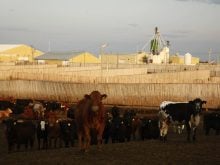This cattle market information is selected from the weekly report from Canfax, a division of the Canadian Cattle Association. More market information, analysis and statistics are available by becoming a Canfax subscriber by calling 403-275-5110 or at www.canfax.ca.
Healthy fed market
Fed cattle prices have averaged more than $260 per hundredweight for the past three weeks. This is the fourth year in a row that first half of the year highs have occurred in June.
Read Also

Huge Black Sea flax crop to provide stiff competition
Russia and Kazakhstan harvested huge flax crops and will be providing stiff competition in China and the EU.
Last week dressed sales were reported from $428-$440/cwt delivered and all three western Canadian packers procured cattle.
Over the previous four weeks, western Canadian fed slaughter has averaged 37,800 head per week, below last year and below the five-year average. Despite smaller slaughter rates in May, cattle are still being worked through at a decent pace.
Year to date western Canadian fed slaughter volumes are down one per cent or 9,000 head compared to last year, while year to date Canadian fed cattle shipments to the U.S. are up 24 per cent or 36,000 head.
In Ontario, Cargill Guelph employees were still on strike. It is estimated this plant accounts for roughly 70 per cent of weekly eastern Canadian cattle slaughter volumes. Eastern Canadian fed cattle are being shipped into Alberta for slaughter.
A potential strike by the Canadian Border Services Agency workers could impact shipments of live cattle and could also impact boxed beef exports and imports.
In the U.S., southern feeding states were at US$185/cwt, $1/cwt weaker. In Iowa, live sales were reported from $188-$190/cwt, steady to $2/cwt lower.
On June 7, live sales in Nebraska were from $189-$190/cwt and dressed deals ranged from $300-$301/cwt. Live and dressed sales were mostly steady with sales the previous week.
U.S. beef exports for April were three per cent lower than last year. Less beef was shipped to South Korea, Hong Kong and China. Year to date U.S. beef exports are down five per cent compared to last year.
Cows still soaring
The western Canadian non-fed market continues to see tailwinds moving into June, with few signs of slowing. Tight cow supplies are supporting prices and resulted in reduced slaughter on both sides of the border.
Alberta D2 cows averaged $194/cwt last week and have been trekking higher for the last 10 weeks. Alberta D3 cows have also moved higher in the last five weeks, closing last week at $175/cwt.
In Ontario, D2 cows averaged $160/cwt last week and have moved mostly sideways for the last 10 weeks.
According to the five-year average, Alberta D2 and D3 cow prices tend to peak in the first week of June, and trend largely sideways with a general weakening tone all the way to November. Alberta cows were on par with US Utility cows in May (converted to $C) and were priced at a $30/cwt premium to Ontario D2 cows.
Year to date non-fed slaughter is down six per cent from last year in Western Canada at 155,901 head, and down 14 per cent in the east at 45,761 head. As the strike at Cargill Dunlop in Guelph continues to impact eastern Canadian slaughter, last week’s eastern non-fed slaughter was 58 per cent smaller than the same week last year, totaling 960 head.
Feeders strengthen
Feeders over 800 pounds traded stronger last week, while lighter-weight cattle saw softer prices. Alberta 800 lb.+ steers traded $3-$3.97/cwt higher, consistent with the trend over the past five years with stronger prices for heavy-weight steers moving into June.
The largest weekly increase was seen in 800-900 lb. heifers, up $11.92/cwt at $309.94/cwt, setting a new record high. Alberta 700-800 lb. steers prices softened $13.82/cwt this week, after trading stronger in the last two weeks
For the month of May, the Alberta 550 lb. steer/heifer spread remained steady at $53/cwt. The 850 lb. steer/heifer spread widened by $11/cwt to $37/cwt. The 850 lb. feeder basis was -$2/cwt in May, $5/cwt stronger than April.
Alberta cow-calf pairs continued to trade higher, averaging $4,772 per pair, an increase of $217 from the previous week and $1,707 stronger than a year ago.
For the week ending May 25, feeder cattle exports to the U.S. totalled 3,994 head, up 74 per cent from last year. Year to date exports reached 69,788 head, also up seven per cent from last year.
U.S. cutouts rise
In U.S. beef trade, Choice cutouts pushed above US$316/cwt twice last week, and closed at $316.21/cwt. Despite modest softening, Select ended the week at $300.83/cwt.
















